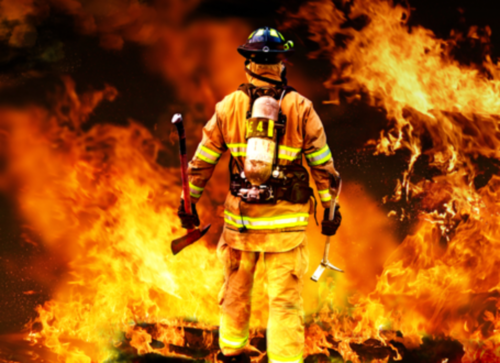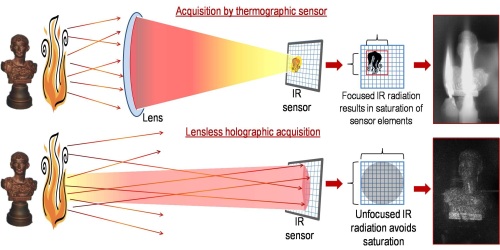One of the greatest challenges a firefighter faces is being able to see through fire and smoke in order to get to people in need of rescue.

(Image via daphneal.com)
At present, firefighters can see through smoke using IR camera technology. The problem with this particular technology, however, is that it can be blinded by the intense infrared radiation emitted by flames, which overwhelm the technology’s sensitive detectors.
A group of Italian researchers looking to improve upon this technology have proposed a new imaging technique that uses infrared digital holography instead.

While IR-camera technology can see through smoke, it can be blinded by flames (top). IR-digital holography, on the other hand, does a better job at avoiding these blind spots (bottom).
Their work was published in the latest publication of Optical Society’s journal, Optical Express .
The benefits of infrared digital holography
The group proposes that their lens-free technique is able to better cope with the flood of radiation when in an environment filled with smoke and flame.
“IR cameras cannot ‘see’ objects or humans behind flames because of the need for a zoom lens that concentrates the rays on the sensor to form the image,” explains Pietro Ferraro of the Consiglio Nazionale delle Ricerche (CNR) Istituto Nazionale di Ottica in Italy. By eliminating the need for the zoom lens, the new technique avoids this drawback.
“It became clear to us that we had in our hands a technology that could be exploited by emergency responders and firefighters at a fire scene to see through smoke without being blinded by flames, a limitation of existing technology,” Ferraro says. “Perhaps most importantly, we demonstrated for the first time that a holographic recording of a live person can be achieved even while the body is moving.”

Two images of a live human subject as seen through flames. When viewed in infrared or white light, the man is almost completely occluded (left). The new system reproduces the image behind the flames using holography, revealing a man wearing a t-shirt and glasses (right).
How holography works
Holography refers to the producing of a 3D image of an object. In order to create a holograph, a laser beam is split into two — an object beam and a reference beam. The former is shone on an object to be imaged. When the reference beam is also shone on this object, an interference pattern is created to encode the 3D image of that object.
But that’s just holography in general. What the researchers did was create a lens-free beam of infrared laser light that gets widely dispersed throughout a room. Since the beam does not employ a lens, light is able to be distributed over the whole array of camera pixels. This helps it avoid oversaturation / blind spots produced by flames.
The infrared laser beams pass through smoke and fire unhindered and when they reflect off the objects and people in the room, the information is recorded by a holographic imager and decoded to reveal everything in the room.
What’s more, objects need not be stationery, as the technology can capture objects in motion.
Below is a video that the team put together to show the new holographic technology:
A side-by-side comparison of a traditional imaging system, in which the view of a man is obstructed by flames, and the new technique, in which the viewer can see the man standing and waving his hand. Credit: Optics Express .
Outlook
While it might sound like this new technology is ready for immediate implementation, the next step is to get it into a portable, tripod-based system that can house both the laser source and infrared camera.
Looking a bit further down the road, the group is also considering a way to get the technology into buildings and tunnels.
Outside of firefighting, the team is considering the technology for use in the biomedical field for non-destructive testing of large aerospace composite structures.
“Besides life-saving applications in fire and rescue, the potential to record dynamic scenes of a human body could have a variety of other biomedical uses including studying or monitoring breathing, cardiac beat detection and analysis, or measurement of body deformation due to various stresses during exercise,” Ferraro says. “We are excited to further develop this technology and realize its application for saving and improving human life.”
The team's paper, “Imaging live humans through smoke and flames using far-infrared digital holography” is available for free download at opticsinfobase.org.
Story via: osa.org
Advertisement





